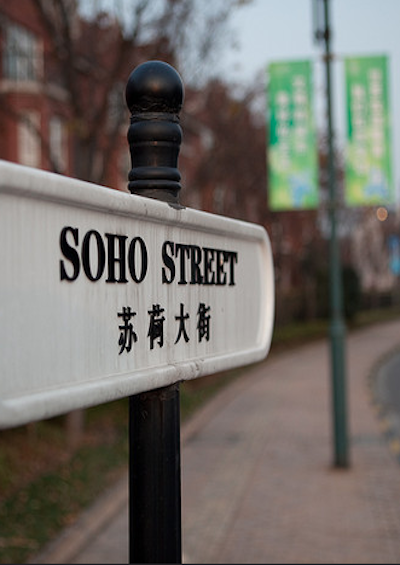Shanghai’s Thames Town: One Potemkin Village Within Another
An English village knock-off serves the ritual of the modern Chinese wedding.
December 27, 2014

The first thing you notice is the brides. Women in flowing white dresses sit on the lawn by the cathedral or stand by the closed door of the church. At first, it seems there are only a few, but gradually you take in the crowds.
Shanghai: In-Depth Look at a Global City
▪ Shanghai – A City Hungry for the Future
▪ Shanghai – Gazing At Its Own Image
▪ Shanghai and China’s Embrace Creativity
▪ Shanghai’s Thames Town
▪ Shanghai: The Underground Economy
▪ Shanghai and Its Environs
▪ Shanghai and Disruptive Innovation
They arrive by the busloads with their elaborate attire and matching grooms. Traditional wedding gowns and tuxedos soon give way to a whole host of colorful costumes.
Couples wearing outfits modeled on Ming dynasty China, a 1920s jazz bar or the palaces of the French Versailles stand only a few feet apart, infusing the surroundings with a postmodern cacophony of time and place.
Their movements are directed by professional photographers who mold them into a standard series of poses — aka, the playful moment, the romantic gaze, the amorous embrace.
Once the set is complete, the pictures will be packaged and ceremoniously displayed. Producing them is among the most important rituals of a modern Chinese wedding. Couples have come to this spot—“Thames Town”—to take advantage of one of the most spectacular backdrops in the city.
It is a faux English village on the edge of the metropolis, which offers a slice of the British countryside in the suburbs of Shanghai.
An urban experiment gone mad?
Thames Town is located in the new town of Songjiang, about an hour from downtown. It was built by the Songjiang New City Construction and Development Company, a semi-private enterprise, linked to the local government. They, in turn, hired the British firm Atkins Consultancy as designers.
Despite the surreal nature of the project, Thames Town is stunningly large. Built to house 10,000 people, it consists of a village green, a waterside promenade, a main shopping district with terraced town houses and suburban style villas.
In both scale and the rigorous manner in which it sticks to its theme, Thames Town — perhaps more than anywhere in the giant megalopolis — gives the impression of an urban experiment gone mad.
Though they were constructed all at once with the typical urgency of China’s high-speed construction, the buildings that make up the town are designed to replicate the different styles and periods of a typical English village.
The aim was to manufacture something that gives the illusion of having grown up over time.
A tour of Thames Town begins at the parking lot on the perimeter. From this approach. it is the villas on the boundaries that are visible first. These vast homes, which are protected by gates and guards, are constructed in the style of manor homes with landscaped gardens that line the banks of a meandering stream.
Through careful landscaping, the traditional canals of the Zhejiang basin have been transformed into an idyllic English river.
Harry Potter and an Urban Planning Museum
The “Ye Olde England” effect is augmented by some kitschy additions placed sporadically on the grounds: castle “ruins,” British-style phone boxes and various statues of the UK’s most famous figures, including Harry Potter.
A man-made lake borders the town and nearby is a large municipal square. Its emptiness is entirely predictable since no one could have ever presumed that Thames Town would have its own municipal government.
Nevertheless, a bank and post office have somehow been persuaded to open branches here, and they share the square with some (not very convincing) signs of galleries “opening soon.”
The main attraction to this part of town is the Urban Planning Museum, which showcases the staggering development of the new town of Songjiang of which Thames Town is only a small part.
In meticulous model replicas of the area, the museum showcases the plethora of new university campuses that form the heart of Songjiang, as well as the planned but not yet built Central Business District.
There also is the surrounding industrial zone, the amusement park, the vast botanic garden, the golf course and the new underwater museums and old mine shaft transformed into a five star hotel.
All this, it is hoped, will transform Songjiang into one of Shanghai’s key tourist destinations.
A weird sense of mirage
Wandering up out of the square, the roads lead downtown into Thames Town’s “historic” core where the streets are narrower and the housing denser. In the middle of the town is a pedestrian zone with cobblestone lanes lined with shops. Though few are open, they have already been given signs, names and phone numbers.
Most are just fronts, their emptiness contributing to the weird sense of mirage that Thames Town exudes. The high street consists of a record shop that never was, which advertises its fantasy stock in the window.
Nearby, the remnant of The Cobb Fish and Chip Shop, was the subject of a court case, since the owners of the real Cobbs in Dorset weren’t amused at being replicated in the Shanghai suburbs.
They needn’t have worried though. There is little evidence in Thames Town that a single piece of fish has ever been sold. Though the sign on the pub and bed and breakfast reads “open all day,” you only have to peek inside to know that this was never meant to be taken literally.
The stores that do exist are make-up studios, photo shops and dress stores designed to cater to the brides. The longest standing suitably-named coffee shop, Incomplete Café, is the perfect satiric comment on the state of the shopping district downtown.
Just beyond the shops a wide-open lawn is surrounded on three sides by a large covered market, empty, of course. The “village green” is dominated by the church, almost an exact replica of a church in Bristol, UK.
Though it is highly unlikely that anyone ever imagined a Christian community living here, the church functions as a key element of Thames Town. For marketing reasons, the developers insisted it be included from the start.
Entirely a local endeavor
Thames Town, with its design, takes the Chinese penchant for copying to a delirious extreme.
Its attempts to synthetically reproduce organic time while simultaneously wiping out all traces of real history, and its plan to artificially implant the culture of suburbia where none had existed before, may seem utterly inauthentic.
Yet, carving out a space on the periphery of the megacity of Shanghai for the implantation of a bucolic village, modeled after a foreign culture and style, is an entirely local endeavor.
Everything about Thames Town — its scale, ambition, remarkable success and obvious failure — is quintessential Shanghai.
Like the wedding photo industry for which it serves as a backdrop, Thames Town is rooted in the specificities of China’s contemporary urbanization. It shows that what is happening on the edges — no less than the core — despite the most blatant forms of mimicry, is not a copy from elsewhere.
Rather, it is a singular experiment that is bound to its own particular history, socio-economic conditions, culture and dreams.
Editor’s note: The above text is adapted from “Shanghai Future, Modernity Remade,” by Anna Greenspan, London, C. Hurst & Company, 2014.

